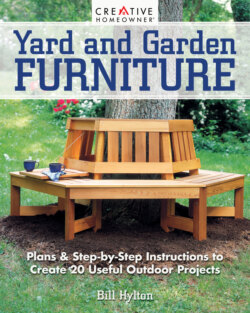Читать книгу Yard and Garden Furniture, 2nd Edition - Bill Hylton - Страница 4
ОглавлениеSAFETY
Though all the designs and methods in this book have been reviewed for safety, it is not possible to overstate the importance of using the safest possible construction methods. What follows are reminders—some do’s and don’ts of work procedures and tool safety that apply to construction projects in general. They are not substitutes for your own common sense.
Always use caution, care, and good judgment when following the instructions and procedures described in this book.
Always be sure that the electrical setup is safe, that no circuit is overloaded, and that all power tools and outlets are properly grounded. Do not use power tools in wet locations.
Always read container labels on paints, solvents, and other products; provide ventilation; and observe all other warnings.
Always read the manufacturer’s instructions for using a tool, especially the warnings.
Use hold-downs and push sticks whenever possible when working on a table saw. Avoid working short pieces if you can.
Always remove the key from any drill chuck (portable or press) before starting the drill.
Always pay deliberate attention to how a tool works so that you can avoid being injured.
Always know the limitations of your tools. Do not try to force them to do what they were not designed to do.
Always make sure that any adjustment is locked before proceeding. For example, always check the rip fence on a table saw or the bevel adjustment on a portable saw before starting to work.
Always clamp small pieces to a stable work surface when working on them with a power tool.
Always wear the appropriate rubber or work gloves when handling chemicals, moving or stacking lumber, or doing heavy construction.
Always wear a disposable or permanent dust mask when you create dust by sawing or sanding. Use a special filtering respirator when working with toxic substances and solvents.
Always wear eye protection, especially when using power tools or driving nails with a hammer. A mis-hit can cause a nail to fly at you.
Never work while wearing loose clothing, hanging hair, open cuffs, or jewelry.
Always be aware that there is seldom enough time for your body’s reflexes to save you from injury from a power tool in a dangerous situation; everything happens too fast. Be alert!
Always keep your hands away from the business ends of blades, cutters, and bits.
Always hold a circular saw firmly, usually with one hand on the trigger handle and the other on the secondary support handle.
Always use a drill with an auxiliary handle to control the torque when large-size bits are used.
Always move a router across a workpiece so that the bit rotation pushes the tool toward the fence rather than away from it.
Never work with power tools when you are tired or under the influence of alcohol or drugs.
Never cut tiny pieces of wood using a power saw. Always cut small pieces off larger pieces that are securely clamped or fastened to a stable work surface.
Never change a saw blade, drill bit, or router bit unless the tool’s power cord is unplugged. Do not depend on the switch being off; you might accidentally hit it.
Never work in insufficient lighting.
Never work with dull tools. Have them sharpened, or learn how to sharpen them yourself.
Never use a power tool on a workpiece—large or small—that is not firmly supported.
Never saw a workpiece that spans a large distance between horses without close support on each side of the cut; the piece can bend, close on and jam the blade, and cause saw kickback.
Never support a workpiece from underneath with your leg or other part of your body when sawing or drilling.
Never carry sharp or pointed tools, such as utility knives, awls, or chisels, in your pocket. If you want to carry such tools, use a special-purpose tool belt with leather pockets and holders.
